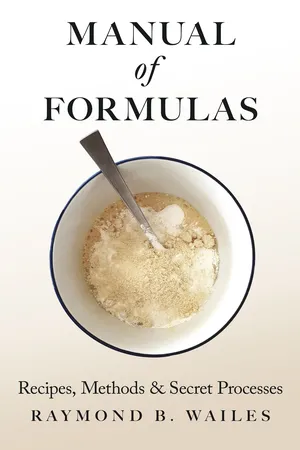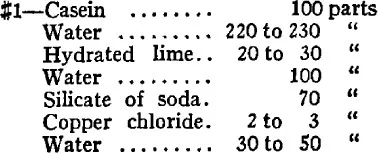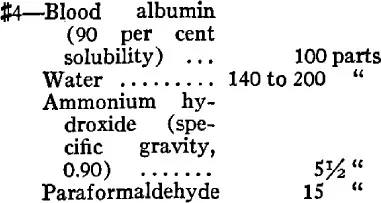
- 260 pages
- English
- ePUB (mobile friendly)
- Available on iOS & Android
eBook - ePub
Manual of Formulas - Recipes, Methods & Secret Processes
About this book
Many of the earliest books, particularly those dating back to the 1900s and before, are now extremely scarce and increasingly expensive. We are republishing these classic works in affordable, high quality, modern editions, using the original text and artwork.
Frequently asked questions
Yes, you can cancel anytime from the Subscription tab in your account settings on the Perlego website. Your subscription will stay active until the end of your current billing period. Learn how to cancel your subscription.
At the moment all of our mobile-responsive ePub books are available to download via the app. Most of our PDFs are also available to download and we're working on making the final remaining ones downloadable now. Learn more here.
Perlego offers two plans: Essential and Complete
- Essential is ideal for learners and professionals who enjoy exploring a wide range of subjects. Access the Essential Library with 800,000+ trusted titles and best-sellers across business, personal growth, and the humanities. Includes unlimited reading time and Standard Read Aloud voice.
- Complete: Perfect for advanced learners and researchers needing full, unrestricted access. Unlock 1.4M+ books across hundreds of subjects, including academic and specialized titles. The Complete Plan also includes advanced features like Premium Read Aloud and Research Assistant.
We are an online textbook subscription service, where you can get access to an entire online library for less than the price of a single book per month. With over 1 million books across 1000+ topics, we’ve got you covered! Learn more here.
Look out for the read-aloud symbol on your next book to see if you can listen to it. The read-aloud tool reads text aloud for you, highlighting the text as it is being read. You can pause it, speed it up and slow it down. Learn more here.
Yes! You can use the Perlego app on both iOS or Android devices to read anytime, anywhere — even offline. Perfect for commutes or when you’re on the go.
Please note we cannot support devices running on iOS 13 and Android 7 or earlier. Learn more about using the app.
Please note we cannot support devices running on iOS 13 and Android 7 or earlier. Learn more about using the app.
Yes, you can access Manual of Formulas - Recipes, Methods & Secret Processes by Raymond B. Wailes in PDF and/or ePUB format. We have over one million books available in our catalogue for you to explore.
Information
MANUAL OF FORMULAS
ADHESIVES
How to Make Glue
The following glue formulas, with directions for mixing, were developed at the Forest Products Laboratory by the laboratory personnel and are available for the free use of the people of the United States and are taken from U. S. Dept. Agr., Department Bulletin #1500.

The 220 to 230 parts of water added to the casein is approximately the right amount to use with Argentine (naturally soured) casein; but if a different casein is used the water requirement will lie somewhere between 150 and 250 parts by weight. The correct amount for different caseins must be determined by trial.
The formula presupposes that a high calcium lime will be used. A lime of lower grade may be used, but a proportionately larger amount of it will be needed, or the water resistance of the glue will be sacrificed. It is suggested that for the first trial the user try 25 parts of lime. If this does not give good results the amount can be varied within the limits specified.
The density of the silicate of soda used should be about 40° Baumé, with a silica-soda ratio of from 3 to 3.25.
Copper sulphate can be substituted for copper chloride.
Place the casein and water in the bowl of the mixing machine and rotate the paddle slowly, stirring the mixture until all the water has been absorbed and all the casein moistened. If the casein is allowed to soak beforehand it is more readily dissolved in the mixing process. Mix the hydrated lime with water in a separate container. Stir this mixture vigorously at first, but just before it is added to the casein stir just enough with a gentle rotary motion to keep the lime in suspension. Pour the milk of lime quickly into the casein.
When casein and lime are first combined they form large, slimy lumps, which are balls of dry casein coated with partly dissolved casein. These break up rapidly, becoming smaller and smaller, and finally disappear. The solution, in the meantime, is becoming thin and fluid. At this point stop the paddle and scrape the sides and bottom of the container, and then stir again. If a deposit of casein remains unacted on, it may cause more lumps later.
When about two minutes have elapsed since the lime and casein were united, it may be noticed that the glue has begun to thicken a little. Add the sodium silicate now, or else the glue will become too thick. The glue will momentarily become even thicker, but this thickness will soon change to a smooth and fluid consistency.
Continue the stirring until the glue is free from lumps. This should not take more than 15 or 20 minutes from the time the lime was added. If the glue is a little too thick, add a small amount of water. If the glue is too thin, it will be necessary to start over again, using a smaller proportion of water.
The copper salt may be added at any one of several times during the mixing process. If added as a powder before the casein is soaked, it may have a corrosive action upon the metal container. The copper salt, if added as a powder, should be thoroughly mixed with the casein before the addition of the lime. Copper salt may be placed in solution and conveniently stirred into the moistened casein immediately before the lime is added or after all the other ingredients have been combined. If the copper solution is added at the end of the mixing period, pour it into the glue in a thin stream and stir the mixture vigorously. Continue stirring until any lumps, which may have formed by the coagulation of the glue and the copper solution, are broken up and until a smooth violet-colored glue is obtained.
Glue prepared by formula No. 1 has proved to be exceptionally strong and durable, even under wet or damp conditions.

Bring the casein and water together according to the directions for mixing glue prepared by formula No. 1. Dissolve the caustic soda in water in a separate container, and while the mixing paddle is revolving sprinkle the caustic-soda solution into the damp casein. Stir slowly until a thin, smooth glue has been obtained. The consistency of the finished product may be altered by adding more casein if it is too thin, or by adding water if it is too thick. Silicate of soda is sometimes added to thicken or to reduce the cost of the glue per unit of volume. This glue has exceptional strength when dry, but when exposed to moisture it weakens as rapidly as animal or vegetable glue.

Pour the larger amount of water over the blood albumin and allow the mixture to stand undisturbed for an hour or two. Stir the soaked albumin until it is in solution and then add the ammonia while the mixture is being stirred slowly. Slow stirring is necessary to prevent foamy glue. Combine the smaller amount of water and the hydrated lime to form milk of lime. Add the milk of lime, and continue to agitate the mixture for a few minutes. Care should be exercised in the use of the lime, inasmuch as a small excess will cause the mixture to thicken and become a jellylike mass. The glue should be of moderate consistency when mixed and should remain suitable for use for several hours. The exact proportions of albumin and water may be varied as required to produce a glue of greater or less consistency or to suit an albumin of different solubility from that specified.

The blood albumin is covered with the water and the mixture is allowed to stand for an hour or two, then stirred slowly. The ammonium hydroxide is next added with more stirring. Then the paraformaldehyde is sifted in, and the mixture is stirred constantly at a fairly high speed. Paraformaldehyde should not be poured in so rapidly as to form lumps nor so slowly that the mixture will thicken and coagulate before the required amount has been added.
The mixture thickens considerably and usually reaches a consistency where stirring is difficult or impossible. However, the thickened mass will become fluid again in a short time at ordinary temperatures and will return to a good working consistency in about an hour. It will remain in this condition for 6 or 8 hours, but when the liquid finally sets and dries, as in a glue joint, it forms a hard and insoluble film.
This glue may be used in either hot or cold presses. When cold pressed, however, it has only moderate strength, and for that reason is not to be depended upon in aircraft construction where maximum strength is required. If hot pressed, it is high in strength and very water resistant.
Preparing Glutin Glue
Place a handful of flour in a piece of muslin and wash it with water, kneading the flour until the wash water is no longer milky from the starch. Glutin remains and should be placed on a glass dish to dry. To use, take a small flake, add a drop or two of water, and allow it to stand 5 or 10 minutes. Knead it until it is soft and then apply.
Yellow Glue
Glue chips are soaked several hours in water,...
Table of contents
- Cover
- Title
- Introduction
- Manual of Formulas
- Index